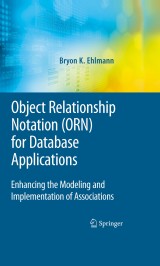Details

Object Relationship Notation (ORN) for Database Applications
Enhancing the Modeling and Implementation of AssociationsAdvances in Database Systems, Band 39
|
CHF 118.00 |
|
| Verlag: | Springer |
| Format: | |
| Veröffentl.: | 05.06.2009 |
| ISBN/EAN: | 9780387095547 |
| Sprache: | englisch |
| Anzahl Seiten: | 246 |
Dieses eBook enthält ein Wasserzeichen.
Beschreibungen
<P>Conceptually, a database consists of objects and relationships. Object Relationship Notation (ORN)<EM> </EM>is a simple notation that more precisely defines relationships by combining UML multiplicities with uniquely defined referential actions.</P>
<P>This book shows how ORN can be used in UML class diagrams and database definition languages (DDLs) to better model and implement relationships and thus more productively develop database applications. For the database developer, it presents many examples of relationships modeled using ORN-extended class diagrams and shows how these relationships are easily mapped to an ORN-extended SQL or Object DDL. For the DBMS developer, it presents the specifications and algorithms needed to implement ORN in a relational and object DBMS. </P>
<P>This book also describes tools that can be downloaded or accessed via the Web. These tools allow databases to be modeled using ORN and implemented using automatic code generation that adds ORN support to Microsoft SQL Server and Progress Object Store.</P>
<P>Object Relationship Notation (ORN) for Database Applications: Enhancing the Modeling and Implementation of Associations is written for research scientists, research libraries, professionals, and advanced-level students in computer science.</P>
<P> </P>
<P>This book shows how ORN can be used in UML class diagrams and database definition languages (DDLs) to better model and implement relationships and thus more productively develop database applications. For the database developer, it presents many examples of relationships modeled using ORN-extended class diagrams and shows how these relationships are easily mapped to an ORN-extended SQL or Object DDL. For the DBMS developer, it presents the specifications and algorithms needed to implement ORN in a relational and object DBMS. </P>
<P>This book also describes tools that can be downloaded or accessed via the Web. These tools allow databases to be modeled using ORN and implemented using automatic code generation that adds ORN support to Microsoft SQL Server and Progress Object Store.</P>
<P>Object Relationship Notation (ORN) for Database Applications: Enhancing the Modeling and Implementation of Associations is written for research scientists, research libraries, professionals, and advanced-level students in computer science.</P>
<P> </P>
I About Relationships and ORN.- Object Relationship Notation (ORN).- ORN Simulator.- Association Patterns.- Comparing ORN to Similar Declarative Schemes.- II Using ORN to Develop a Database System.- ORN Additive.- Object Relater (OR+).- Mapping Database Models to DDLs.- Association Semantics.- III Adding ORN to a DBMS.- A Conceptual Implementation of ORN.- Adding ORN to the SQL Standard for RDBMSs.- Adding ORN to the ODMG Standard for ODMSs.
<P>Conceptually, a database consists of objects and relationships. Object Relationship Notation (ORN)<EM> </EM>is a simple notation that more precisely defines relationships by combining UML multiplicities with uniquely defined referential actions.</P>
<P>This volume shows how ORN can be used in UML class diagrams and database definition languages (DDLs) to better model and implement relationships and thus more productively develop database applications. For the database developer, it presents many examples of relationships modeled using ORN-extended class diagrams and shows how these relationships are easily mapped to an ORN-extended SQL or Object DDL. For the DBMS developer, it presents the specifications and algorithms needed to implement ORN in a relational and object DBMS. </P>
<P>This book also describes tools that can be downloaded or accessed via the Web. These tools allow databases to be modeled using ORN and implemented using automatic code generation that adds ORN support to Microsoft SQL Server and Progress Object Store.</P>
<P>Object Relationship Notation (ORN) for Database Applications: Enhancing the Modeling and Implementation of Associations is written for research scientists, research libraries, professionals, and advanced-level students in computer science.</P>
<P> </P>
<P>This volume shows how ORN can be used in UML class diagrams and database definition languages (DDLs) to better model and implement relationships and thus more productively develop database applications. For the database developer, it presents many examples of relationships modeled using ORN-extended class diagrams and shows how these relationships are easily mapped to an ORN-extended SQL or Object DDL. For the DBMS developer, it presents the specifications and algorithms needed to implement ORN in a relational and object DBMS. </P>
<P>This book also describes tools that can be downloaded or accessed via the Web. These tools allow databases to be modeled using ORN and implemented using automatic code generation that adds ORN support to Microsoft SQL Server and Progress Object Store.</P>
<P>Object Relationship Notation (ORN) for Database Applications: Enhancing the Modeling and Implementation of Associations is written for research scientists, research libraries, professionals, and advanced-level students in computer science.</P>
<P> </P>
Provides unique association patterns that help make database modeling easier and more exact Unique ORN notation closes the gap between database modeling and definition, thus improving database development productivity Describes Web-accessible tools that allow databases to be modeled using ORN and implemented using automatic code generation that adds ORN support to Microsoft SQL Server and Progress Object Store Includes supplementary material: sn.pub/extras


















